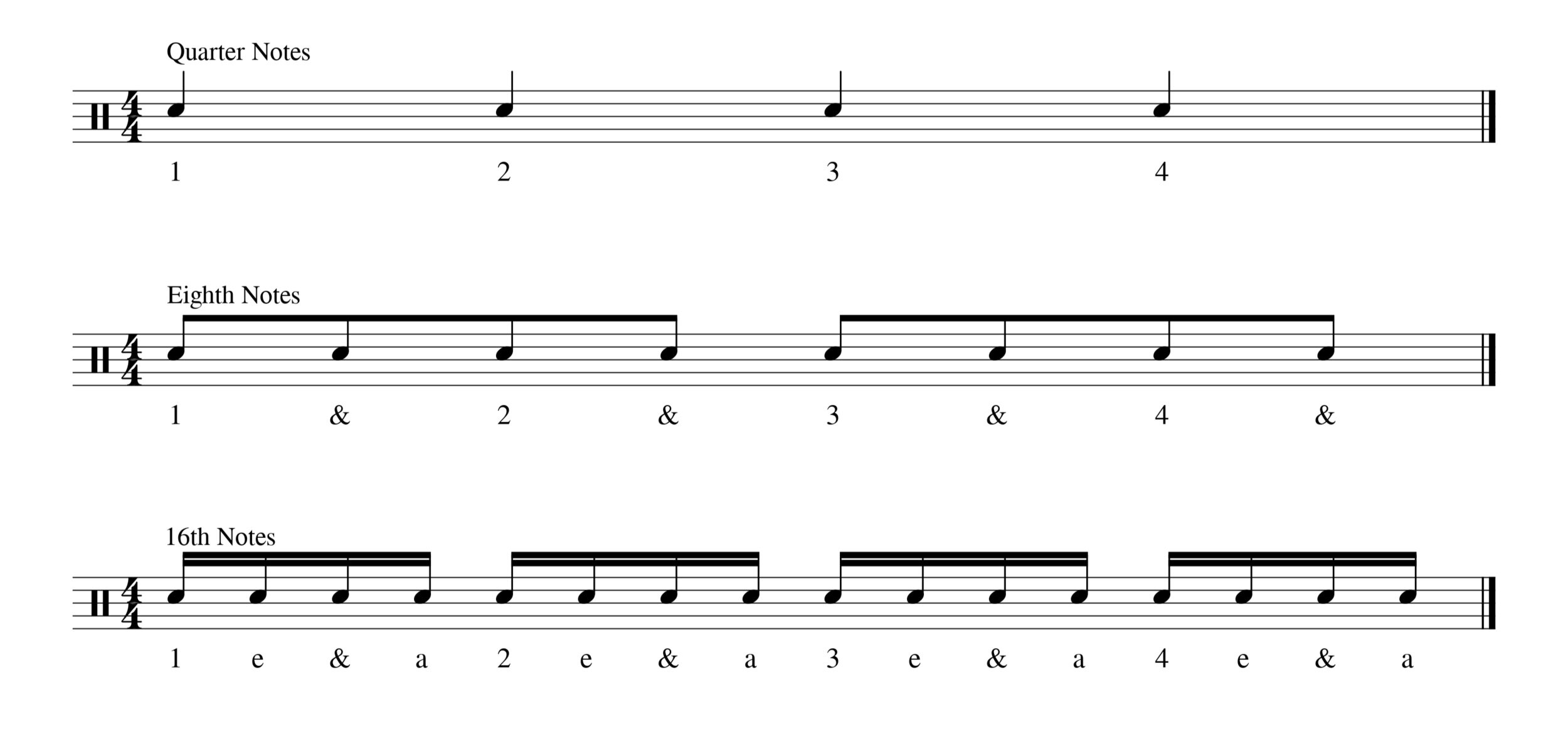Lesson 6: Sixteenth Notes - Part 1
Overview: This video covers Sixteenth Notes, the Table Of Time, and the multiple-measure repeat sign.
Assignment: Joel Rothman's Teaching Rhythm, pages 26 - 28 : Get The Book (paid link)
You can also get a metronome here: Get the Metronome (paid link)
Welcome back to the Rhythm and Reading Series. This lesson is the first part of two about 16th Notes. What I find fun about where we are at right now is that we are just about wrapping up the foundations of rhythm.
Hopefully you've started to see that there's a formula that you'll be able to tap into to be able to create new rhythms and interpret difficult rhythms as you come across them in your playing.
I'll start this lesson by introducing the Table Of Time (fig. 1). You may run across this table in many different method books.
I like using a table of time because it gives a visual representation of how the rhythms relate to each other. You can click the image below to download a PDF version.
Each level of the table of time is a single measure of music in 4/4.
At the top is the whole note, which takes up four quarter note beats (fig. 2). There is one whole note in this measure. The beat is counted out for you below the music.
Fig. 2 Table Of Time - Whole Note Level Source: www.ChristianJohnsonDrums.com
The table of time is a useful visual tool because of the way the rhythms line up. The next level is half notes. You should be able to tell that the half note takes up only two beats of the measure (fig. 3).
Fig. 3 Table Of Time - Half Note Level Source: www.ChristianJohnsonDrums.com
The half notes can be split into quarter notes, giving us four quarter notes (fig. 4). This matches our time signature!
Fig. 4 Table Of Time - Quarter Note Level Source: www.ChristianJohnsonDrums.com
From there, you learned about 8th notes. Since there are two 8th notes per quarter note, you'll have 8 eighth notes in the measure (fig. 5).
Fig. 5 Table Of Time - 8th Note Level Source: www.ChristianJohnsonDrums.com
If you follow that pattern, by splitting rhythms in half, you'll get 16th Notes next. They are a subdivision of 8th notes.16th notes fit in between 8th notes the same way 8th notes fit in between quarter notes.
Fig. 6 Table Of Time - 16th Note Level Source: www.ChristianJohnsonDrums.com
Sixteenth notes are made up of a solid note head, stem and two flags. They can also be beamed together, like 8th notes, and would have two beams (fig. 7).
Fig. 7 Unbeamed and Beamed 16th Notes Source: www.ChristianJohnsonDrums.com
What's cool about the table of time is that it's clear that four 16th notes make up one quarter note beat. 16ths are often beamed in groups of 4 to make the beat easy to see, similar to how 8th notes are beamed in pairs. Check out my video at 3:55 to see what I mean.
Below is how to count 16th notes (fig. 8). Again, the table of time makes it a bit easier to see how the numbers always line up with the metronome. You should also notice that the "&'s" all line up too. The e's and a's are subdivisions. I count 16th’s out loud for you in my video starting at 4:43.
Fig. 8 Counting 16th Notes Source: www.ChristianJohnsonDrums.com
When you count the 16th note subdivision, even if you're only playing quarter notes and 8th notes, you will improve your timing. This is a great way to get "tight" as a musician. Your rhythms start to be more and more accurate because you're able to count an appropriate subdivision.
Pages 26 through 28 in Teaching Rhythm include 16th notes mixed with all of the previously learned rhythms. It's important to keep counting the subdivisions as you play.
Fig. 9 Sixteenth Notes Source: Teaching Rhythm, Joel Rothman (c) 1967 Joel Rothman
You’ll notice that Rothman’s count is written slightly differently than how I do it, but the result is the same sound. He says “1-e-an-duh”.
I think this is because the hard “d” sound of “duh” adds some percussiveness to the syllable, and makes it easier to play with authority and confidence. You can choose what works best for you.
One pitfall for many new musicians is to confuse 16th notes with "playing fast." When you see 16th's they aren't necessarily fast.
All they are is the next subdivision of the quarter note. So if you're playing in a slow tempo, the 16th's won't always be "fast". You must keep counting to play them correctly.
Finally, you may notice on page 28 there's a new Element of Music. It looks similar to the single repeat sign from the previous lesson, but in this case, it overlaps two measures (fig. 10).
This Multiple Measure Repeat Sign means to play the previous TWO measures again. Just like the single measure repeat sign, this is a shorthand way for the composer to have you play the same thing over again, without having to write it twice. It’s also a way to point out a musical phrase as a complete idea that is then repeated.
Fig. 10 Multi-measure Repeat Sign Source: Teaching Rhythm, Joel Rothman (c) 1967 Joel Rothman
That's it for Part 1 of 16th Notes. In Part 2, I'll show you how 8ths and 16ths can be combined to create new and interesting rhythms.
You can get all of the videos in the Rhythm and Reading Series right to your inbox weekly by subscribing to my newsletter here or be notified when I post new videos by subscribing to my YouTube channel.









